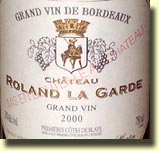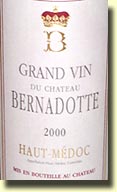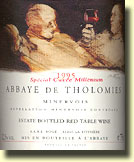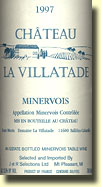
|
|
5 from Volpaia
We
recently got our hands on the new vintages of red wines from the respected
Tuscan producer Castello di Volpaia, and having had little
experience with them, we were quite jazzed to try them out. Further
stimulating our interest was the fact that they were made by renowned
innovator Riccardo Cotarella, whose previous successes
include Montiano and Montevetrano, not to mention his own
family’s Falesco estate. And so we assembled a crew of
tasters that included Frank Joyce, Mary Ann Barnett, Alan
Kerr, Lowell Boileau and Scott “the Geek” Tobias to
see what the wines are all about, and I’m happy to report that we were
most pleased with what we found. 2001
Castello di Volpaia Borgianni Chianti D.O.C.G., 90% Sangiovese, 7% Canaiolo, 3%
Malvasia, $9.99, 12.8% alc.: Fermented in stainless steel for 10 days at
80-86º F; then left for another 8 days before the liquid is run off the
skins before malolactic fermentation in “stainless steel containers.”
This dark garnet “basic” Chianti features flavors and aromas of black
cherries and chocolate that Alan described as “earthy red cherries.”
It’s not too tannic, with zippy acidity, good concentration, a fairly
nice finish and if it’s not that complex, what do you want for $10?
A pleasant wine that should improve over the next few years. 2000
Castello di Volpaia Chianti Classico D.O.C.G., $18.99, 13% alc.: From the Piano
al Prato, Campo a Pitti, Piaggia Delgli Albeti, Casetto and Santa Maria
Novella Vineyards. The grapes were fermented in their own
yeast at between 27 and 30º C for 14 days, and automatically punched down
twice a day. After macerating on the skins for 10 more days,
malolactic fermentation started, and in January and February the wine was
transferred to Slavonian oak barrels ranging from 1,500 to 3,500 litres
for 14 months. A little darker in color than the Borgianni, the rich
dark cherry and blackberry character of this wine is accented with “a
lot of mushroom, a little dried prune and chocolate,” according to Mr.
Kerr. The latter quality comes out more as it opens, and there’s a
good brace of tannins, but not so much that you can’t drink and enjoy it
now. The acidity is a little lower than in the Chianti, perhaps
adding to the warm, velvet-y texture, and the nice finish shows hints of
tar. Kerr and Frank like this, but wouldn’t pay the cost; I like
it too, and I might just buy a few. 1999
Castello di Volpaia Chianti Classico Riserva D.O.C.G., 90% Sangioveto, 10%
Merlot / Pinot Noir / Syrah, $28.99, 12.8% alc.: From the Santa Maria
Novella, Casavecchia, Campo a Pitti, La Docciola and Campo Alla Fonte
Vineyards; sees essentially the same process as the Chianti Classico,
except that maceration on the skins lasted 7 days and the aging in
Slavonian oak AND small French oak barriques was for 2 years. Alan
pointed out that this deep dark garnet has “a lot of structure,”
certainly more than the previous two. The stingy black fruit nose
isn’t showing much, but the flavors pick it up nicely, with impressions
of dried cherries and black cherries shaded with floral tones of violets
and little hints of licorice, and while the French oak is apparent, it’s
in nice proportion to the whole package. There are good tannins
here, but they’re refined, with no astringency, with zippy acidity and a
nice finish. Deep, dark and delicious, with more red fruit emerging
as it opens, this little lovely should go a good ten years, no sweat. 1999
Castello di Volpaia Balifico Toscana I.T.G., $45.99, 13% alc.: Sangioveto di Volpaia
(a native clone) and Cabernet Sauvignon. Sees essentially the same
process as the Chianti Classico, except that it macerated on the skins for
8 days and was aged in Allier oak barriques for about 18 months.
Another deep dark garnet that’s not giving much on the nose other than
some heat and faint traces of mint, according to Kerr, this one fans out
on the palate with flavors of red currant, black cherry, cassis, toffee
and chocolate, along with hints of smoke and licorice. This is like
velvet on the palate, with silky tannins and ample acidity that almost
seems understated, and it finishes very nicely indeed. Beautifully
structured and balanced, it’s lovely to drink now, but has a promising
future, and while the oak is again apparent, it’s in proportion. 1999
Castello di Volpaia Coltassala Chianti Classico Riserva D.O.C.G., $45.99, 13%
alc.: Sangioveto and Mammolo, no percentages given. Sees essentially
the same process as the Balifico, except that it macerated on the skins
for 10 days. Not as dark a garnet as the last two, and not as stingy
on the nose either, though it’s not exactly effusive, with red currant,
black cherry and subtle chocolate aromatics that echo and expand on the
palate with even more silky tannins than the previous selections; Frank
noted a floral element, while Alan added impressions of a little spice and
pepper. It’s not quite as dense as the Balifico or the CCR, but
it’s more fruit driven than those, having excellent acidity and a long
finish. It’s the most “international” in style of the five
Volpaia wines, and also the most elegant, and the clear favorite of most
of the tasters (I may have preferred the Balifico slightly).
Despite the obvious aging
potential, these are all eminently drinkable already, and paired admirably
with a progression of marvelous food courses that included Kim’s
Pacchetti di Melanzane alla grigia (grilled aubergine parcels with
mozzarella, tomato and basil), Bruscchetta Casalinga, Kerr’s Il carpaccio
fatto da Alan, (raw beef tenderloin), and Kim’s Pollo al Chianti
(chicken with Chianti, grapes and fresh bitter greens), and Il
PolentaInfornato Col Pomodoro (baked polenta with tomato). Castello di Volpaia wines are imported by William Grant and Sons, Inc., Edison, NJ. A
Horizontal of 2000 Ferraud Beaujolais Our friends Errol and Patty
Kovitch sent us an invitation to what they billed as their “1st
Annual Beaujolais Party,” to be held on March 29th, 2003. This
intrigued me for a couple of reasons. First, Beaujolais isn’t one
of the “movers and shakers” in the world of wine, although I know
folks who love the stuff produced there. Second, Errol is no
newcomer to wine, so he must know something about this stuff, right?
All 12 wines showed a consistent
“house” style throughout, with most of the differences being in
subtlety and nuance. P. Ferraud & Fils is one of the oldest
firms in Beaujolais, having been established in 1882, and one of the few
that still matures its wine in huge 6000 litre barrels, or foudres.
Some of the wines come from family’s own vineyards, while others are
from domains and chateaux exclusive to Ferraud. I started with the simple
Beaujolais and tasted through in the order suggested by the producer. 2000
P. Ferraud & Fils Beaujolais: Ruby red, a little darker in color
than your average rosé, with the basic raspberry, cherry and strawberry
profile that is found pretty much throughout the entire lineup; medium
body, with a certain earthiness and light tannins that might benefit from
a year or so in the cellar. Straightforward and pleasant, a decent
wine to sip slightly chilled on a summer afternoon. 2000
P. Ferraud & Fils Beaujolais Villages: Slightly darker ruby garnet
than the Beaujolais, with somewhat deeper flavors and aromas in the same
basic profile, and some added mineral to boot. A little more of
everything than the last wine. 2000 P.
Ferraud & Fils Regnié Cuvée Antoine Ferraud: Ruby dark garnet,
this is almost indistinguishable from the Beaujolais Villages, except for
a silky elegance that the previous model doesn’t have. 2000
P. Ferraud & Fils Chiroubles Domaine de La Chapelle des Bois: Ruby
dark garnet, with a pretty floral perfume that adorns the black cherry,
raspberry bouquet, and flavors to match. Silky smooth, with just a
hint of earth; not too tannic, with perfectly balanced acidity. 2000 P.
Ferraud & Fils Brouilly Domaine Rolland: Dark garnet, heavy on the
black cherry on the nose, then back to the black cherry and raspberry
profile on the palate. Again, a certain floral quality and a
silkiness that makes this easy to like. 2000 P.
Ferraud & Fils Juliénas Château d’Envaux: Ruby garnet, with an
earthy black cherry and raspberry character that shows just a hint of
underbrush that adds some complexity and interest. Again, not too
tannic, nice acidity and silky smooth. 2000
P. Ferraud & Fils Cote-De-Brouilly Domaine Rolland: Ruby dark
garnet, with earthy black cherry flavors and aromas, but without the
floral quality of the Brouilly; doesn’t finish all that long. A
step up from the Beaujolais Villages, but perhaps a step down from the
other cru wines. 2000 P.
Ferraud & Fils Fleurie Domaine du Clos des Garands: Ruby dark
garnet, somewhat floral black cherry and raspberry character with good
concentration, silky tannins and a nice finish. Right there with the
Brouilly as the best of the bunch so far. 2000
P. Ferraud & Fils Saint-Amour Domaine Toutant: Ruby garnet with a
slightly smoky tinge, and a little more effusive bouquet than any of the
previous wines. Somewhat floral black cherry character with a hint
of mahogany, nice concentration and a silky texture; the most singular
wine of the bunch, and neck and neck with the Fleurie and Brouilly as the
cream of this crop. 2000 P.
Ferraud & Fils Morgon Domaine de l’Evêque: Dark garnet; another
one with aromatics that jump right out of the glass. Lots of fruit,
with big black cherry flavors and aromas shaded with earthy undertones; a
little more tannic than any of the others, and almost chunky by
comparison. 2000 P.
Ferraud & Fils Chénas Côte Remont: Ruby garnet, very floral with
what seems to be a note of oak in the black cherry, raspberry and vanilla
flavors and aromas. Not too tannic, with the most acidity of the
bunch and a nice finish; very pretty. 2000
P. Ferraud & Fils Moulin-A-Vent L’éolienne: Ruby dark garnet,
with nice round black cherry and raspberry flavors and a nose to match.
Another silky wine, but maybe just a bit less intense and concentrated
than the other cru wines. A trowel full of dirt adds interest. I like these wines, especially the
crus that are so noted. By and large, they’re a different animal
from what we’re used to, and while I wouldn’t make a steady diet of
them, they’re certainly a most refreshing change of pace. Kudos to
the Ferraud family and the much maligned Gamay Noir varietal, and many
thanks to the Kovitches for their generosity and warm hospitality.
2000 Château Recougne Bordeaux Supérieur, $9.99, 12.5% alc.: A deep dark garnet with a deep dark cassis, black currant, leather and lead pencil nose that carries over onto the palate with a bit of a tannic bite, but not so much that you can’t enjoy it now, especially with air. As it opens, it gains notes of tobacco, bitter chocolate and “a sea breeze,” according to Shar. Everyone liked this quite well, and of all the wines, this was the one that was the most traditional in style. Excellent QPR. 2000 Château Plaisance Primieures Côtes de Bordeaux, $14.99, 12.5% alc.: Another dark garnet, this shows black currant, plum and chocolate flavors and aromas, but doesn’t have the quite the concentration or intensity of the Recougne; it also has a bit of the wet dog fur on the nose. Shar described it as “perfumed,” while Kim called it “eminently drinkable,” and while there are good tannins and acidity here, it’s still very approachable, with a slightly creamy texture and a note of oak. It was also very well received, but I liked the Château Recougne a bit better. 2000 Château des Annereaux Lalande de Pomeral, $19.99, 12.5% alc.: This dark garnet was opened when another selection in about the same price range proved to be corked. Shar found it “a little poopy,” but I didn’t get any of that; to me, it was all about plum, red and black currants and a little pipe tobacco. Surprisingly, it’s very approachable and not that tannic. You can really spot the merlot in this.
2000 Château Roland la Gard Premieres Côtes de Blaye, $23.99, 13% alc.: This inky garnet was a stand-in for yet another corked bottle (one costing around $36, no less, not that TCA discriminates against price points), and it proved to be as popular as just about any other selection of the evening. It features a gorgeous nose of perfumed plum, black currant, red currant and a nice note of chocolate, all of which follow through very nicely in the flavors. The significant tannins can’t hide the lovely fruit; this could almost be mistaken for a Californian wine, and I don’t mean that in a bad way. It was a wonderful evening that left everyone glowing, all warm and fuzzy. It also left us with the distinct impression that there are some damned good 2000 Bordeaux out there. We KNOW the big guns are going to be killer, but we were most pleased to find some in this price range that showed so well. This may call for some further investigation…
4 from Minervois I've gotten to the point where my tastes have become very specific when it comes to QPR reds, and they're quite different from what they were even a year or so ago. Where once I really enjoyed things like the Rancho Zabaco Zinfandels and the bargain wines of Spain, they just don't do it for me like they used to. Now I like the dry reds from southern France, with little or no apparent oak, and those from Minervois stand out among them. Here're four of the best that I've found recently.
Imported by International Gourmet Corp., Atlanta, Georgia
Imported by J et R Selections, Ltd., Mt. Pleasant, MI 1998 Domaine La Combe Blanche Minervois “Cuvée Tradition,” $11.59, 13% alc.: Comprised of 33% 100 year old Carignan, 33% 100 year old Cinsault, and 33% Syrah & Grenache, from mountain vines yielding less than 3 tons per acre, this spent 12 months in 1 and 2 year old French oak barrels. Another that I stumbled upon when there were only a few left on the shelves, this ever so slightly rusty dark garnet maintains a more or less similar profile to the other two, with it’s deep, dark earthy black currant, plum, iodine and olive aromatics that show a noticeable note of the barnyard. These follow through on the palate with a big, chewy mouthful of rich, tannic fruit that lingers nicely, despite the ample tannins. There’s a certain broad texture in the mouth, and I say that because the wine is still a little too young and rambunctious to be “smooth” just yet, but still, it washes over the tongue and down the gullet with a nice harmony to it. And like so many of the better reds from southern France, it just keeps opening and opening with air. This may well be a 10-year wine; it’ll certainly be drinking even better by ’05 or ’06. Imported by Hand Picked Selections, Warrenton, VA 1999 Chateau d'Oupia
Minervois, $9.99, 13% alc.: We used to drink a lot of the
’95 vintage of this wine back in ’98 and ’99; we also enjoyed
their more prestigious Cuvée des Barons and Nobilis
bottlings around then, but those dried up around these parts after the
’92 and ’91 versions respectively. Then, for some reason I
stopped buying it altogether until just this past August, don’t ask me
why. That’s when I was surprised to run into a cache of the ’96,
and decided to try it again, and guess what? It was good, really
good. I went back and bought some more, we drank it up, and then I
went back and bought the rest. We drank that up too, but I never did
post any notes on the stuff. Don’t ask me why. Fortunately, another joint in the neighborhood has a
bunch of the ’99, so I’ve been buying that, and it’s just about as
good as the ’96. In fact it’s probably even a little less tannic
than the older stuff; otherwise, they’re very similar. The blend
is 60% Carignane, 30% Syrah, and 10% Grenache; the wine is a deep, almost
inky purple garnet in color, with flavors and aromas of black currant and
black berries, accented with hints of black olives, dark chocolate and
iodine. It has the tannins to go for at least a few years in the
cellar, and yet it’s drinking so well now that if you’re like me, you
may have a hard time keeping your hands off. It has good acidity,
making it very food friendly, and yet I’m sitting here sipping some now
as I type these notes enjoying it all by its lonesome. This is some
rich, concentrated juice, almost more than one has a right to expect for
the price, and it finishes quite nicely, topping off a very appealing
package. Like I said, don’t ask me why I abandoned this old friend for so long; I’m just glad that I came back to it. The 2000 model is available now, and while it's good, it's not AS good as the '99, so if you can find any of the latter, by all means, buy it. Buy ALL of it! A Louis/Dressner Selection – Imported by LDM Wines, Inc., New York, NY 10012
|
|
|

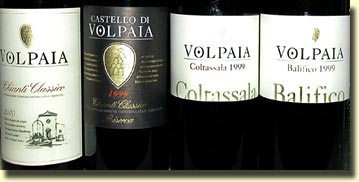
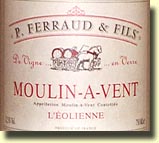 The
wines themselves were a complete horizontal of the 2000 vintage produced
by
The
wines themselves were a complete horizontal of the 2000 vintage produced
by 